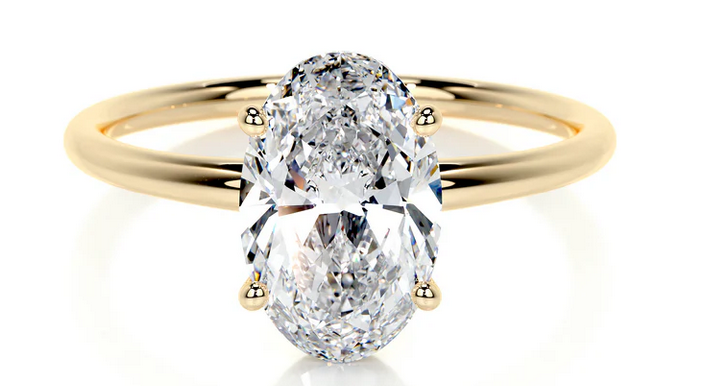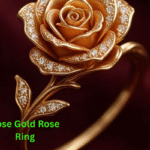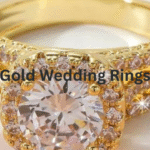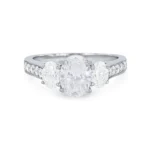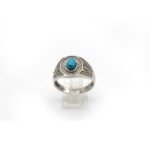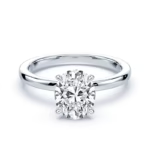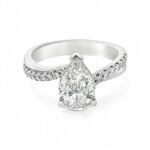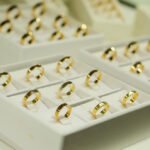In a world where sustainability and ethics are reshaping consumer choices, lab created diamond rings are emerging as the ideal option for modern buyers.These diamonds were once regarded with suspicion, but they are now valued for their beauty, affordability, durability, and ethical and environmental advantages.
From celebrities to environmentally conscious millennials, the shift towards lab created diamond rings signals a new era in the world of fine jewelry. But what exactly are these diamonds? How do they compare to natural ones? And why are they poised to revolutionize the industry?
In this comprehensive guide, we’ll delve deep into the world of lab created diamond rings, explore their science, advantages, and myths, and help you understand why they’re becoming the future of fine jewelry.
Table of Contents
What Are Lab Created Diamond Rings?
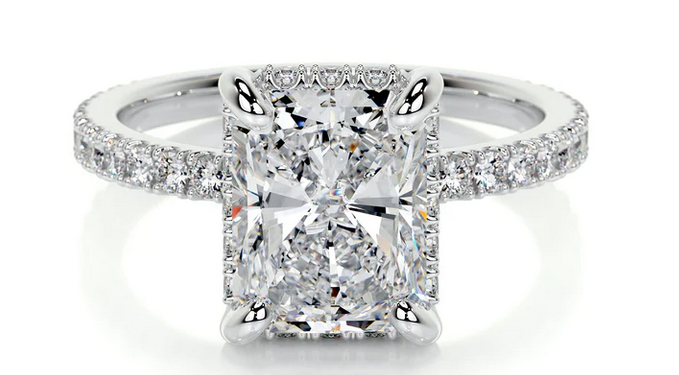
Lab created diamond rings are made using diamonds that are grown in laboratories rather than mined from the earth. These diamonds are chemically, physically, and optically identical to natural diamonds but are formed in a controlled environment.
There are two main processes used to create lab-grown diamonds:
• High Pressure High Temperature (HPHT)
This process simulates the natural circumstances that lead to the formation of diamonds.
• Chemical Vapor Deposition (CVD)
This involves placing a diamond seed in a carbon-rich gas chamber that forms the diamond layer by layer.
Despite their synthetic origins, lab diamonds are real diamonds—not to be confused with cubic zirconia or moissanite.
The Rise of Lab Created Diamond Rings in the Jewelry Industry
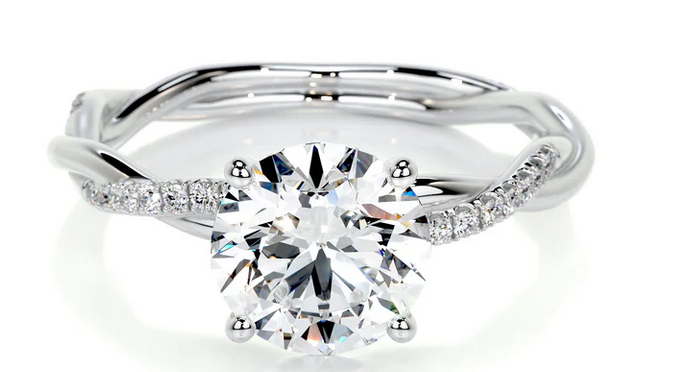
Over the past decade, there has been a surge in the popularity of lab created diamond rings. According to market studies, lab-grown diamond sales have increased by over 15% annually, with more jewelers expanding their offerings to include these stunning alternatives.
This rise can be attributed to three key factors:
1. Ethical Concerns
Customers are becoming more aware of where items come from. Human rights abuses and environmental damage have long been associated with conventional diamond mining. Lab-grown diamonds provide a cruelty-free alternative.
2. Affordability
Compared to their natural counterparts, laboratory-created diamonds are usually 30–40% less expensive. Customers may get larger or better-quality stones without going over their budget because to this pricing differential.
3. Environmental Sustainability
Creating diamonds in labs uses significantly less land and causes far less environmental disruption compared to mining.
Comparing Lab Created Diamonds vs Natural Diamonds
Feature Lab Created Diamonds Natural Diamonds
Origin: produced underground over billions of years and cultivated in a controlled laboratory.
Price 30-40% cheaper More expensive
Ethical Conflict-free and sustainable May be linked to unethical mining
Quality Identical in appearance and properties Natural uniqueness and rarity
Certification Certified by IGI, GIA, etc. Certified by same institutions
While both types of diamonds are real, many buyers are leaning toward lab created diamond rings for their ethical and financial advantages.
The Technology Behind Lab Created Diamonds
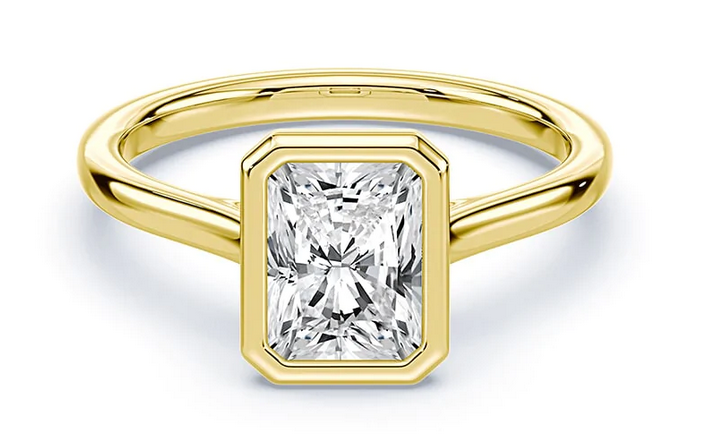
The creation of lab-grown diamonds is nothing short of a technological marvel. In both HPHT and CVD processes, a tiny diamond seed is used as the starting point.
• HPHT
Subjecting the seed to temperatures over 1500°C and pressures of over 1.5 million pounds per square inch, carbon atoms deposit and crystallize onto the seed, forming a diamond.
• CVD
In this method, carbon gas is heated until it breaks apart and deposits carbon onto the diamond seed, creating layers over time.
The result is a diamond that is chemically and physically indistinguishable from a mined diamond. Expert gemologists cannot tell the difference without specialized equipment.
The Benefits of Lab-Crafted Diamond Rings
1. Ethical Jewelry
Choosing lab created diamond rings means opting for diamonds that are guaranteed conflict-free. These diamonds are not linked to exploitative labor or war zones, making them a guilt-free luxury.
2. Environmentally Friendly
Traditional diamond mining is destructive, involving removal of tons of earth, deforestation, and high water usage. In contrast, lab-grown diamonds have a smaller carbon footprint and are far less taxing on the planet.
3. Cost-Effective Luxury
One of the biggest appeals of lab created diamond rings is affordability. You can often get a bigger, higher quality diamond for the same price you would pay for a smaller mined diamond.
4. Wide Design Options
Because lab diamonds are more affordable, you can experiment with custom designs, larger carats, or even pair multiple stones without breaking the bank.
________________________________________
Myths and Misconceptions About Lab Created Diamond Rings
Lab diamonds continue to be the subject of several misconceptions despite their widespread use. Let’s debunk a few:
Myth 1: Lab diamonds are fake.
Fact: Lab-grown diamonds are physically and chemically similar to real diamonds. They are simply manufactured in a lab rather than on the ground.
Myth 2: Lab diamonds don’t sparkle like natural ones.
Fact: Lab-created diamonds are evaluated according to the same criteria as real diamonds and have the same fire and brilliance.
Myth 3: Lab diamonds have no resale value.
Fact: While natural diamonds often have better resale value due to rarity, many jewelers now offer trade-in and upgrade options for lab-grown diamonds.
Who Should Buy Lab Created Diamond Rings?
● Engaged Couples on a Budget
Want a bigger stone without overspending? For engagement rings, lab-created diamond rings are quite affordable.
● Eco-Conscious Consumers
If you’re looking to reduce your carbon footprint, lab diamonds are the sustainable choice.
● Modern Jewelry Enthusiasts
Lab-grown diamonds are a perfect fit for those who appreciate modern technology and ethical sourcing.
Celebrities Embracing Lab Created Diamond Rings
Many high-profile celebrities are proudly wearing lab created diamond rings, making them even more mainstream. Stars like Meghan Markle, Emma Watson, and Penélope Cruz have all supported ethical jewelry lines featuring lab diamonds.
Care and Maintenance for Lab Created Diamond Rings
The same maintenance is needed for lab-created diamonds as for genuine diamonds:
• Clean regularly using warm water and mild soap.
• Avoid exposing your ring to harsh chemicals.
• Store separately to avoid scratches.
• Get it inspected annually for setting integrity.
Their durability (a 10 on the Mohs hardness scale) ensures that your lab created diamond rings will last a lifetime with proper care.
Frequently Asked Questions
Q:1. Are lab created diamond rings real diamonds?
Answer:
Yes, they are real diamonds with the same chemical and physical properties as mined diamonds.
Q:2. How long do lab created diamonds last?
Answer:
Forever. Like natural diamonds, lab-created diamonds are extremely durable and don’t degrade over time.
Q:3. Are lab diamonds cheaper than mined diamonds?
Answer:
Indeed. Compared to real diamonds of the same size and grade, lab-created diamonds are usually 30–40% less costly.
Q:4. Can a diamond ring made in a lab be insured?
Answer:
Absolutely. Most insurance companies will insure lab-created diamonds just like natural diamonds.
Q:5. Do diamond rings made in a lab have certifications?
Answer:
Yes. They are certified by reputable labs like IGI and GIA, using the same standards as mined diamonds.
Q:6. Will diamonds produced in a lab pass a diamond test?
Answer:
Yes, because they are real diamonds, they will pass standard thermal and electrical conductivity diamond tests.
Q:7. Can you tell the difference between lab and natural diamonds with the naked eye?
Answer:
No. Only advanced laboratory equipment can distinguish the origin of a diamond.
Q:8. Are lab created diamonds eco-friendly?
Answer:
Yes, they use significantly fewer natural resources and cause less environmental harm than traditional mining.
Q:9. What settings work best with lab created diamonds?
Answer:
Any setting that works with a natural diamond also works with a lab-created diamond—solitaire, halo, vintage, or modern.
Q:10. Do lab created diamonds come in fancy colors?
Answer:
Yes, lab-grown diamonds come in a range of beautiful hues, such as pink, yellow, and blue.
Conclusion
The world of fine jewelry is undergoing a quiet revolution—and lab created diamond rings are at the heart of it. As more consumers become aware of the environmental and ethical costs of traditional diamond mining, the appeal of lab-grown alternatives continues to grow.
With their unmatched value, real diamond brilliance, and socially responsible creation, lab created diamond rings are not just a trend—they’re the future.
Whether you’re shopping for an engagement ring, a timeless anniversary gift, or a stunning fashion statement, choosing lab-created diamonds is a choice that aligns with both your heart and your conscience.
So the next time you’re looking to sparkle, consider a ring that shines with beauty, innovation, and integrity.
